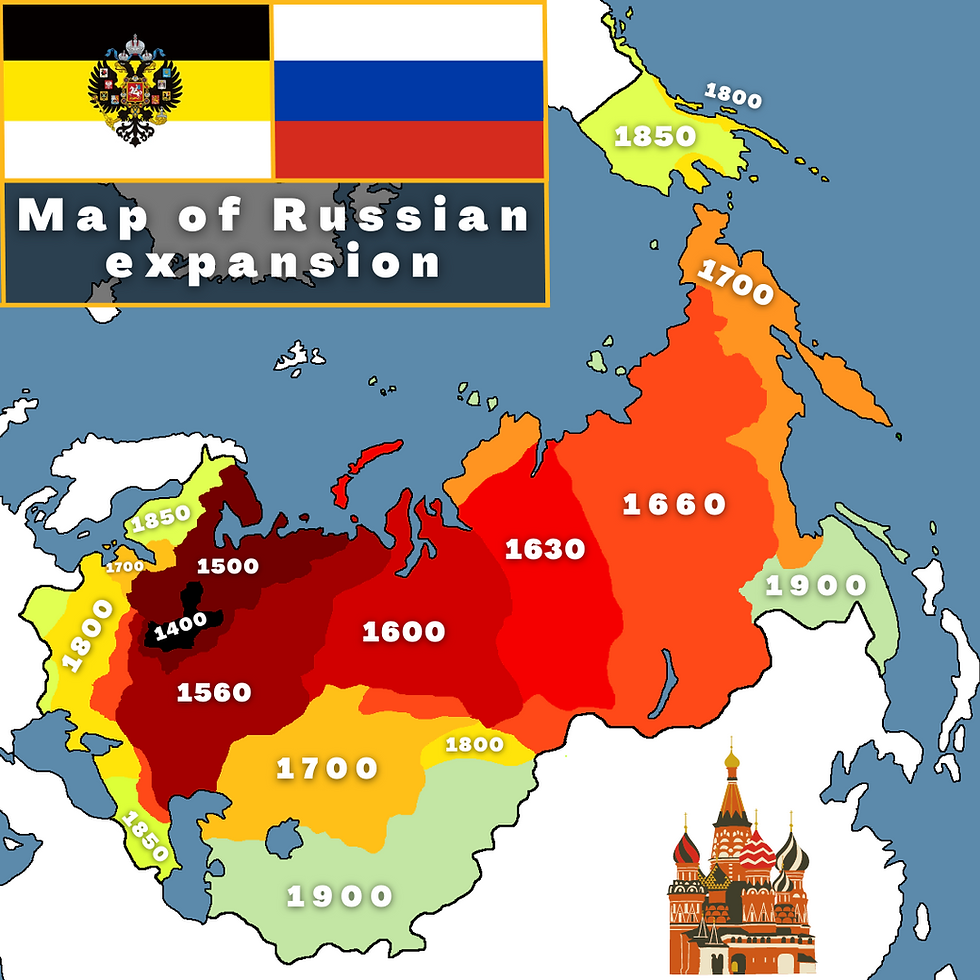Russian Expansion
- hunmapper

- Apr 13, 2022
- 3 min read
Russia, the largest country on our planet used to be even larger in the past. But how did a minor principality in Eastern Europe became one of the largest Empires in Human History?

Before Russia
In the 9th century the land of the Eastern Slavs was united into a single state: the Kievan Rus. The state adopted Christianity from the Byzantine Empire around 1000. The Rus' was defeated by the Mongols and several smaller principalities were formed under Mongol overlordship. After the 13th century, Moscow became a political and cultural center. By the end of the 15th century, Moscow united the northeastern and northwestern Russian principalities, in 1480 finally overthrew the Mongols.
Grand Duchy of Moscow (1283–1547)
The power of the Mongols started to decline in the 14th century and the Grand Princes of Moscow started to openly oppose their overlords. In 1380 at the famous battle of Kulikovo the Russians defeated the Mongols. Although this hadn't brought an end to the Tatar rule in Russia it earned great glory for Grand Prince Dmitry Donskoy. Moscow's leadership in Russia was now firmly based and by the middle of the 14th century its territory had greatly expanded through purchase, war, and marriage. In the 15th century, the grand princes of Moscow continued to consolidate Russian land to increase their population and wealth. The most successful practitioner of this process was Ivan III.
After the Fall of Constantinople (1453) Moscow became the New Rome of the East.
Tsardom of Russia (1547–1721)
The Tsardom of Russia was formally created in 1547 and lasted until Peter the Great declared the Russian Empire in 1721 after his victory over Sweden. In this period Russia grew on average by 35,000 km2 per year. In 1613 the first Romanov was crowned as the Tsar of Russia. The Romanov Dynasty ruled Russia until the February Revolution in 1917.
This was the era of the "Great Siberian Expansion" and by 1700 Russian settlers reached the Pacific Ocean.
Russian Empire (1721–1917)
Shortly after the Empire was founded Russia lived a golden age while many of it's neighbours were declining (Swedish Empire, Ottoman Empire, Polish-Lithuanian Commomnwealth, Qing China) In 1720 the state had only 15.5 million inhabitants, which increased to 170 million in 1914. Russia fought several wars with the Ottoman Empire, but the largest threat to the State was Napoleon's invasion in 1812. Russia also had to fight the Ottoman British and French armies in the Crimean War (1854-55). The war resulted in a defeat for Russia, however only little territory was lost. Russian explorers crossed the Bering Strait, settled in Alaska and established the Russian American Company. After unsuccesful attempts of colonizing California and Hawaii Russia had to sale Alaska because of a financial crisis in 1867. The Trans-Siberian railway was built in the latter half of the 19th century, bringing the eastern parts of the country closer to the Russian homeland. Russia joined the Great War to protect Serbia but the Russian Army suffered heavy lossed to the Germans and Austro-Hungarians. By the middle of 1915, the impact of the war was demoralizing. Food and fuel were in short supply, casualties were increasing, and inflation was mounting. Strikes rose among low-paid factory workers, and there were reports that peasants, who wanted reforms of land ownership, were restless. The emperor eventually decided to take personal command of the army and moved to the front, leaving his wife, the Empress Alexandra, in charge in the capital. The Tsar was overthrown in the February Revolution in 1917 and one year later the entire Romanov family was excecuted by the Bolsheviks.
Sources:




Comments